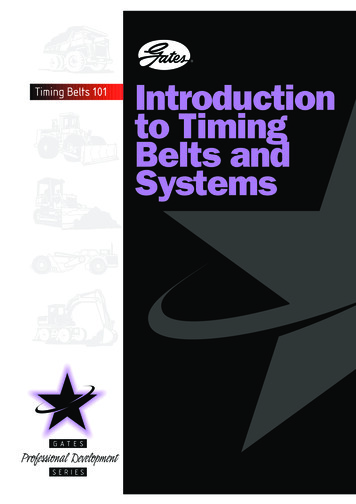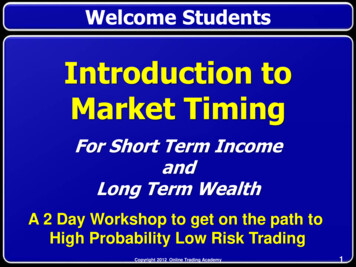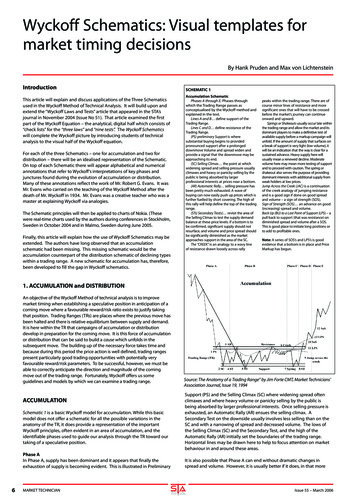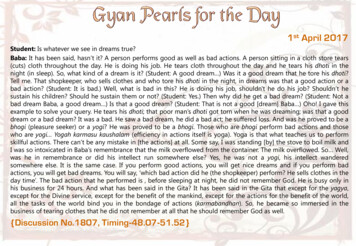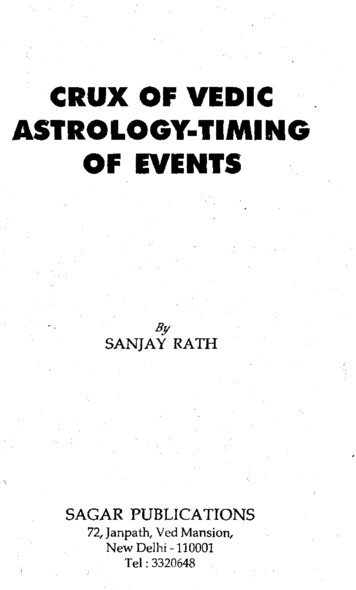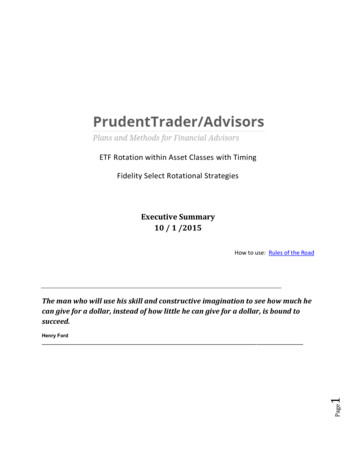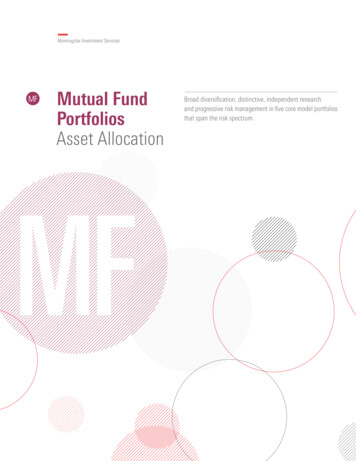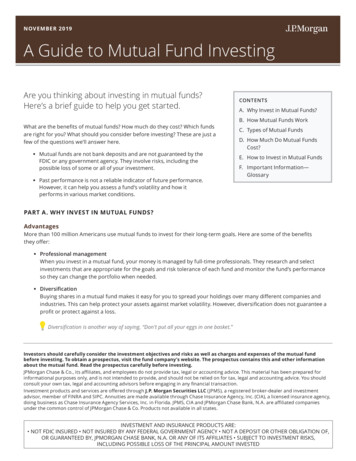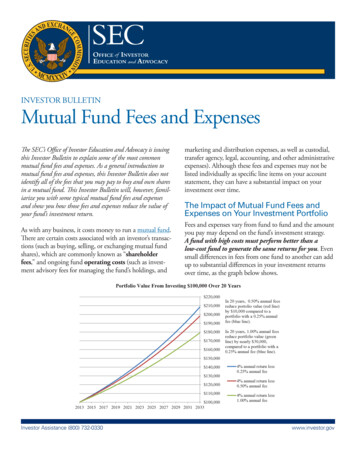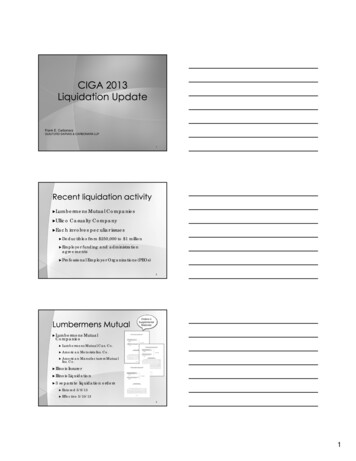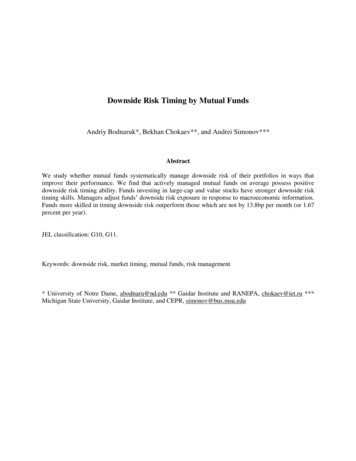
Transcription
Downside Risk Timing by Mutual FundsAndriy Bodnaruk*, Bekhan Chokaev**, and Andrei Simonov***AbstractWe study whether mutual funds systematically manage downside risk of their portfolios in ways thatimprove their performance. We find that actively managed mutual funds on average possess positivedownside risk timing ability. Funds investing in large-cap and value stocks have stronger downside risktiming skills. Managers adjust funds’ downside risk exposure in response to macroeconomic information.Funds more skilled in timing downside risk outperform those which are not by 13.8bp per month (or 1.67percent per year).JEL classification: G10, G11.Keywords: downside risk, market timing, mutual funds, risk management* University of Notre Dame, abodnaru@nd.edu ** Gaidar Institute and RANEPA, chokaev@iet.ru ***Michigan State University, Gaidar Institute, and CEPR, simonov@bus.msu.edu
Downside Risk Timing by Mutual FundsAbstractWe study whether mutual funds systematically manage downside risk of their portfolios in ways thatimprove their performance. We find that actively managed mutual funds on average possess positivedownside risk timing ability. Funds investing in large-cap and value stocks have stronger downside risktiming skills. Managers adjust funds’ downside risk exposure in response to macroeconomic information.Funds more skilled in timing downside risk outperform those which are not by 13.8bp per month (or 1.67percent per year).JEL classification: G10, G11.Keywords: downside risk, market timing, mutual funds, risk management
“Our team maintains a strict focus on downsiderisk management as we remain fully invested inthe equity markets.”Jerry Miccolis, CIO of Giralda Advisors1. IntroductionThe financial economics literature has firmly established that investors do not treat upward anddownward price movements symmetrically, but exhibit greater sensitivity to losses than to gains. Lossaverse investors require a premium for holdings assets which returns correlate greatly with the market whenthe market goes down. Thus, securities which pose high downside risk have higher average returns, i.e.,they deliver abnormally positive returns in good times to compensate investors for losses sustained duringmarket declines (Ang, Chen, and Xing, 2006).The important implication of this phenomenon for asset management is that mutual fund managers canachieve superior returns by shifting funds between high and low downside risk stocks in anticipation ofbroad market movements. In our paper we examine whether mutual funds systematically manage downsiderisk of their portfolios in ways that improve their (risk-adjusted) performance.Management of portfolio’s downside risk is inherently related to managers’ market timing skills as bothstrategies rely on the ability to predict the direction of future market price movements. A fund managerengaged in market timing would increase fund’s exposure to the market by shifting funds from cash andbonds to stocks as well as increase fund’s holdings of high regular beta stocks prior to market advances andwould decrease exposure to the market prior to market declines. The abnormal performance relative to thepassive benchmark is, thus, achieved by switching to assets, which returns correlate strongly with themarket in general, before markets go up.11Earlier evidence (Treynor and Mazuy, 1966, Henriksson and Merton, 1981, Becker, Ferson, Myers, and Schill, 1999,Jiang, 2003) suggested that fund managers on average do not have market timing skills. More recent studies (e.g.,Chance and Hemler, 2001, Bollen and Busse, 2001, Jiang, Yao, and Yu, 2007), however, find positive market timingability.1
In contrast, if a manager engaged in downside risk timing (hereafter DRT) anticipates the market to goup (down), she would increase (decrease) the fund’s ownership of stocks which stand to lose in bad times,i.e., high downside risk stocks. Hence, the abnormal value created by this strategy accrues to loading onstocks, which stand to lose a lot in a down market, prior to upward market movements. These two strategies– market timing and downside risk timing – would be identical if stock returns’ comovements with marketreturns were symmetric; but they need not be the same if stocks comove more with the market when themarket goes down than when it goes up (Hong, Tu, and Zhou, 2007).Which of these strategies would a manager pursue? Market timing and downside risk timing are notmutually exclusive strategies, but could rather be used to complement each other. Indeed, if a manageranticipates the market to go up, he may move funds from safer to riskier assets (market timing) and withinthese riskier assets choose stocks with higher downside beta (downside risk timing). Additionally, mutualfunds’ mandates in general restrict funds from holding large cash positions which inhibits their ability totake bets on the direction of market movement.2 Indeed, Yan (2006) shows that aggregate cash holdings bymutual funds do not forecast future returns implying that cash management is not a good indicator of markettiming skills by the managers. By actively managing downside risk of a fund’s portfolio, a manager canbenefit from his ability to predict market returns without violating this restriction. This suggests thatdownside risk timing is likely to be of first order importance.Though our paper is the first formal academic investigation of the downside risk timing activities bymutual funds, the financial industry itself has long recognized the importance of managing downside riskfor serving clients’ needs and improving performance. For example, Janus Orion fund described itsinvestment goals in 2006 prospectus as “seek[ing] to outperform the benchmark index while managingThe following quote from the Oppenheimer Equity Income Fund’s prospectus provides an example of suchrestriction on cash holdings: “It [the fund] will invest at least 80% of its net assets, plus borrowings for investmentpurposes, in equity securities”. Simutin (2014) concludes that cash holdings while imposing drag on performance,allow managers to make quick investments in attractive stocks and satisfy outflows without costly fire sales.22
downside risk.”3 A simple Factiva search identifies close to one thousand mutual funds discussingmanagement of downside risk in their 2013 prospectuses.4To organize our thinking of the concept of downside risk timing, we extend Henriksson and Merton(1986) model of market timing. We show that managers which do not possess forecasting abilities aboutfuture direction of the market choose optimally not to engage in market timing of any kind. Managers withintermediate abilities engage in classical market timing. Finally, managers with higher forecasting abilityare more likely to follow downside risk timing strategies.To evaluate downside risk timing of mutual funds, we follow the approach of Jiang, Yao, and Yu (2007)and construct a measure based on observed mutual fund portfolio holdings. Specifically, for each fund weestimate its relative beta as the weighted average of downside market betas of the individual stocks held inthe portfolio net of the weighted average of their regular market betas. We then test whether the covariancebetween the abnormal changes in fund’s relative beta and holding period market returns – which we denoteas Downside Risk Timing or DRT – is significant. Since we focus on changes in downside beta net ofchanges in regular beta this covariance measures downside risk timing in excess of market timing byconstruction.Our holdings-based measure of downside risk timing skills has several advantages over traditionallyused returned based measures which are derived from nonlinear regressions of realized fund returns againstcontemporaneous market returns (e.g., Henriksson and Merton, 1981, Treynor and Mazuy, 1966). First, anynon-linear relation between fund returns and market returns may not reflect the timing abilities of themanagers, but instead could be induced by certain dynamic trading strategies or option-like featuresembedded in returns of some portfolio stocks (Jagannathan and Korajczyk, 1986). Second, return-basedmeasures suffer from look-ahead bias as they rely on ex-post realized returns to estimate beta shifting.Holdings-based measures use only ex-ante information on portfolio holdings.3At the beginning of 2006, the fund was ranked in the 89th percentile in terms of downside risk timing skills estimatedover the previous 60 month window.4The reported number includes fixed income funds as well as multiple classes of shares by equity mutual funds.3
We conduct our analysis on a sample of 4,921 actively managed U.S. equity mutual funds over theperiod from 1982 and 2011. We demonstrate that, on average, mutual funds have significant positive DRTability over three and six month horizons. This result is robust to explicitly accounting for funds’ markettiming activities and most pronounced in more actively managed funds as measured by “active share”(Cremers and Petajisto, 2009).Downside risk timing ability does not depend on fund size, expense ratio, or turnover. However, fundswhich tend to invest in large-cap and value stocks appear to have stronger downside risk timing skills.Managers also adjust funds’ downside risk exposure in response to macroeconomic information, inparticular to the level of both short-term and long-term interest rates, credit premium, and aggregateearning-to-price ratio. Our results, however, remain strong even after controlling for both fund-specific andmacroeconomic variables.Funds skilled in downside risk timing tend to increase their ownership of small stocks and are lessinclined to move into growth stocks prior to market increases; they are also less eager to unload momentumstocks prior to market declines. The observed differences in portfolio reallocations, however, are relativelysmall in magnitude suggesting that changes in downside risk exposure are achieved by shifting fundsbetween stocks with similar characteristics, but different downside betas.Finally, we assess the economic consequences of downside risk timing. We demonstrate that fundswhich are more skilled in timing downside risk outperform those who do not: zero-cost strategies based onfunds’ DRT abilities generate abnormal performance of 13.8 bp per month (or 1.67 percent per year). Thisperformance is stronger during the down markets; however, it is still economically and statisticallymeaningful in upmarkets.The paper which is most complementary to ours is Polkovnichenko, Wei, and Zhao (2015). They arguethat actively managed mutual funds respond to investors’ demand to curtail tail risk by reducing downsiderisk of their portfolios while at the same time still trying to capture upside potential. Polkovnicheko et al.(2015) show that returns of actively managed value funds exhibit stronger downside hedging properties4
than passive benchmarks. Our results indicate that funds not only limit their downside risk exposure, butalso manage it in value enhancing ways.The remained of the paper is organized as follows. Section 2 describes measures of downside risktiming and the nature of our tests. Section 3 presents descriptive statistics of our data. In Section 4, weexamine mutual fund downside risk timing. Section 5 explores the characteristics of downside risk timers.In Section 6 we explore how down risk timing relates to public information about the state of the economy.Section 7 investigates the mechanisms of downside risk timing. In Section 8 we quantify the economicimpact of DRT. A brief conclusion follows.2. Measures of Downside Risk TimingMutual funds can take advantage of anticipated movements in stock market prices by changing theirownership of assets which strongly comove with the market (market timing) and/or by varying theirownership of securities which value is very sensitive to market declines (downside risk timing). 5 These twostrategies are not necessarily independent of each other; in fact, they would be identical if stock returns’comovements with market returns were symmetric, i.e., upside and downside betas of the assets were thesame. Hong et al. (2007), however, show that stocks comove more with the market when the market goesdown than when it goes up, implying that stocks’ downside betas are larger than their regular and upsidebetas.Assessment of downside risk management by mutual funds is complicated by the fact that thecorrelation between downside beta and regular beta is on average high 0.77.6 Fund manager aiming tochange the downside beta of his portfolio would be simultaneously affecting its regular beta as well. We5Fund managers can also use derivative instruments to take directional bets on the market. Trading of derivatives,however, seem to be an exception rather than the rule. For example, Almazan, Brown, Carlson, and Chapman (2004)report that even though over 70% of actively managed funds do not have restrictions on trading options, only 12.4%of those which are permitted to do so trade them. Deli and Varma (2002) show that mutual funds use derivativesprimarily to reduce transaction costs, not to manipulate fund’s level of risk; funds tend to permit investment only inthose derivatives that offer transaction-cost benefits.6Ang et al. (2006) report the correlation of 0.78 at the individual stocks level.5
therefore measure downside risk timing activities of mutual funds as changes in downside beta spurringfrom active trading in excess of changes in regular beta.In doing so, we follow the approach of Jiang et al. (2007) and derive our measure of downside risktiming ability from fund’s portfolio holdings. As the first step, we estimate fund’s relative downside betaas the weighted average of the downside betas of the individual stocks held in fund’s portfolio net of theweighted average of the regular betas. Active Change in Relative Beta or ACRB then is defined as thechange in fund’s relative beta due to active trading from quarter 𝑡 1 to 𝑡.𝑁𝑡𝐴𝐶𝑅𝐵𝑡 (𝛽̂𝑡 𝛽̂𝑡 ) 𝜔𝑖𝑡 (𝑏̂𝑖𝑡𝑖 1𝑁𝑡 1𝑡 1 ̂ 𝑏̂𝑖𝑡 ) 𝜔𝑖𝑡(𝑏𝑖𝑡 𝑏̂𝑖𝑡 ) .(1)𝑖 1 where 𝜔𝑖𝑡 is the fund portfolio weight of asset 𝑖 at quarter 𝑡, 𝑏̂𝑖𝑡and 𝑏̂𝑖𝑡 are downside and regular betaestimates of asset 𝑖 at quarter 𝑡, 𝑁𝑡 1 and 𝑁𝑡 is the number of assets held in the fund portfolio at quarter𝑡 1𝑡 1 and 𝑡, and 𝜔𝑖𝑡is the passive portfolio weight of asset 𝑖 at quarter 𝑡 inferred from fund portfolioholdings at quarter 𝑡 1.Downside and regular betas of asset 𝑖 at time 𝑡 are estimated from monthly stock returns over the prior36 months. We use monthly instead of, for example, daily returns as they are more appropriate for capturinginvestment horizon and performance evaluation periods of fund managers. Daily fluctuations in portfoliovalue should have little impact on decisions of managers whose performance is evaluated over much longertime intervals. For cash and non-equity holdings, we assume a monthly rate of return equal to the onemonth T-bill rate; correspondingly, they are assigned both regular and downside beta values of zero. Forstocks with less than 36 months history of returns we assign regular and downside betas of the stock in thesame SIC2-industry most similar in terms of market capitalization; our results are not affected if we limitour analysis to funds with holdings of such stocks below 5% of total assets under management. ACRB isequal to zero if a fund maintains its portfolio constant between quarters 𝑡 1 and 𝑡. The ACRB is positiveif the most recently disclosed holdings have larger relative beta, i.e., downside beta less regular beta, thanholdings observed a quarter before.6
An important feature of our analysis is that we use identical time periods to estimate betas applied toboth past and current portfolio holdings. In this way we ensure that when measuring fund’s downside risktiming activities we capture changes in downside risk exposure induced by active changes in the portfoliocomposition rather than changes in market conditions.In the second step, we relate active changes in relative beta over the past quarter to the future monthlymarket returns. The coefficients 𝛾1 and 𝛾2 from the following fund-by-fund time series regressions provideestimates of fund’s downside risk timing ability:𝐴𝐶𝑅𝐵𝑡 𝛼 𝛾1 𝑟𝑚,𝑡 1,𝑘 𝜂𝑡 1,𝑘(2)𝐴𝐶𝑅𝐵𝑡 𝛼 𝛾2 Ι𝑟𝑚,𝑡 1,𝑘 0 𝜂𝑡 1,𝑘(3)where 𝑟𝑚,𝑡 1,𝑘 is the monthly market return in the month 𝑘 (1,2,3) in the quarter 𝑡 1 and Ι𝑟𝑚,𝑡 1 ,𝑘 0 isan indicator that takes the value of one when monthly market return 𝑟𝑚,𝑡 1,𝑘 0 and zero otherwise. Thespecifications of these regressions are similar to those of Jiang et al. (2007) in their analysis of mutual fundmarket timing skills.The loading estimates 𝛾1 and 𝛾2 describe the sensitivity of each 𝐴𝐶𝑅𝐵𝑡 to the latent factor driving theforecast target. As Kelly and Pruitt (2013, p. 1727) point out, in this type of forecasting regressions, each𝐴𝐶𝑅𝐵𝑡 is a function of only the expected portion of future returns and is uncorrelated with unanticipatedfuture shocks. Therefore, time-series regression coefficients of 𝐴𝐶𝑅𝐵𝑡 on 𝑟𝑚,𝑡 1,𝑘 and Ι𝑟𝑚,𝑡 1,𝑘 0 describehow each fund’s active change in relative beta depends on the true expectation of future market return.The 𝛾1 and 𝛾2 coefficients estimated from (2) and (3) could be interpreted as the Treynor-Mazuy (1966)and Henriksson-Merton (1981) type measures of DRT ability, respectively. A significant positive 𝛾indicates positive downside risk timing and implies that a fund increases its exposure to securities, whichstand to lose a lot in a down market, prior to upward market movements.7
3. Data and Summary StatisticsWe use several data sources in our analysis. CRSP mutual fund data base provide information aboutfund performance as well as a host of fund characteristics such as assets under management, expenses, age,and investment style. Mutual fund portfolio holdings come from Thomson Financial CDS/Spectrumdatabase; it contains long positions in domestic common stock holdings. Though prior to 2004 funds wererequired to disclose their holdings semiannually, over 80% of observations are updated quarterly. We mergethese two datasets using the MFLINKS files based on Wermers (2000) and available through WhartonResearch Data Services. Individual stock returns come from CRSP monthly stock files. CRSP valueweighted index return is used as a proxy for the market return. We use one-month T-bill yields to measurerisk-free rate. Our sample covers the time period between 1982 and 2011.Since our focus is on active portfolio decisions of fund managers, we exclude index funds from ouranalysis. Additionally, we remove foreign-based funds, U.S.-based international funds, fixed income andbalanced funds, real estate funds, precious metal funds, and money market funds. We also exclude fundsthat manage less than 10 million; funds with missing portfolio ownership over two quarters are alsoremoved. For funds with multiple share classes, fund-level variables are computed as value-weightedaverages.Table 1 reports the summary statistics of the main fund attributes. Our sample includes 4,921 distinctfunds and 123,810 fund-quarter observations with valid abnormal changes in relative beta, ACRB. Thenumber of funds ranges from a minimum of 193 in 1982 to a maximum of 1881 in 2011. By averaging firstover time series for each fund and then across funds, we obtain the following characteristics: the averagetotal net assets (TNA) of the funds in our sample is 718 million, with quarterly return of 2.13%, an annualturnover ratio of 90.6%, and an annualized expense ratio of 1.18%. The funds invest 91.2% of their assetsin common stocks. The average age of the fund, calculated as the time between the first and the last returnobservation in CRSP Mutual fund data set, is 12.7 years. The mean number of stocks held is 106. Overalldescriptive statistics of our sample of mutual funds is very similar to other studies analyzing managerial8
portfolio decision
For example, Janus Orion fund described its investment goals in 2006 prospectus as “seek[ing] to outperform the benchmark index while managing 2 The following quote from the Oppenheimer Equity Income
